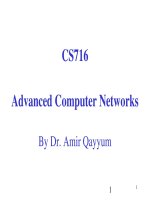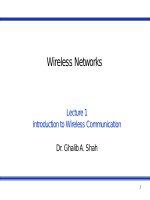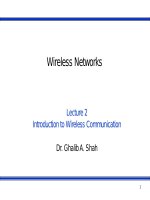Wireless networks - Lecture 38: Security/Extensions of WSN
Bạn đang xem bản rút gọn của tài liệu. Xem và tải ngay bản đầy đủ của tài liệu tại đây (606.03 KB, 30 trang )
Wireless Networks
Lecture 38
Security/Extensions of WSN Part V
Dr. Ghalib A. Shah
1
Outlines
Security primitives in TinySec
Encryption Schemes
Keying mechanism
WMSN
►
►
►
►
►
Architecture
Applications
Advantages
Design Considerations
Protocols
WSAN
►
►
►
►
Motivation
WSN vs WSAN
Architecture
Issues
2
Last Lecture
Transport Protocols for WSN
TCP/UDP for WSN
Protocols
► PSFQ
► ESRT
► CODA
Security Threats in WSN
TinySec
Motivations of Link Layer security
3
Security Primitives
Message Authentication code
► A cryptographic secure checksum for checking the message
integrity
► Computing a MAC requires authorized senders and receivers
to share a secret key, and this key is part of the input to a MAC
computation
► if an adversary alters a valid message or injects a bogus
message, she cannot compute the corresponding MAC value
Initialization vector (IV)
► Encrypting the same plaintext two times should give two
different ciphertexts (semantic security).
► A common technique for achieving semantic security is to use
a unique initialization vector (IV) for each invocation of
algorithm
► A side input to the encryption algorithm.
4
TINYSEC-DESIGN
2 Security Options► Authentication Encryption ( Tinysec-AE)
• TinySec encrypts the data payload and authenticates the
packet with a MAC.
• The MAC is computed over the encrypted data and the
packet header.
► Authentication only (Tinysec-Au)
• TinySec authenticates the entire packet with a MAC, but the
data payload is not encrypted.
Encryption : semantically secure encryption
typically requires two design decisions
► Specifying the IV format
► Selecting an encryption Scheme
5
Tinysec IV format
IV too long- add unnecessary bits to the packet
Too short – Risk of repetition
How long should be the IV? N bit IV repeat after 2^n
+1.
► If we use a n bit counter repetitions will not happen before that
point.
► Pseudorandom would repeat with probability of 2^(n/2)
Destination
Active message handler type
6
Encryption schemes
Symmetric key encryption schemes fall into two classes
► Stream ciphers
• A stream cipher (typically) uses a key K and IV as a seed
and stretches it into a large pseudorandom keystream
GK(IV ).
• The keystream is then xored against the message
• stream ciphers have a devastating failure mode: if the same
IV is ever used to encrypt two different packets, then it is
often possible to recover both plaintexts
► modes of operation using block ciphers.
• block cipher is a keyed pseudorandom permutation over
small bit strings, typically 8 or 16 bytes
•
•
CBC is the most appropriate scheme for sensor networks –why?
Works better with repeated IVs.
7
CBC
IV is XOR'ed with the first data block before it is encrypted.
Feed the result of encryption back into the encryption of the next
block.
The plain-text is XOR'ed with the previous cipher-text block before
it is encrypted.
The encryption of each block depends on all the previous blocks.
This requires that the decryption side processes all encrypted
blocks sequentially
An error in an encrypted block
►
►
►
causes the block with the error to be completely garbled.
The subsequent block will have bit errors at the same positions as the
original erroneous block.
The blocks following the second block will not be affected by the error.
Hence, CBC is self-recovering
8
Keying mechanism
Use per-link keying,
► separate Tinysec key for each pair of node wishing to
communicate.
► Drawback: Key distribution becomes a challenge.
Allow a group of nodes to share a TinySec key rather
than each pairs.
► Group keying provides an intermediate level of resilience.
Appropriate keying mechanism for a particular network
depends on several factors.
Tinysec key- A pair of skipjack key-one for
authentication, one or encryption.
Simplest keying mechanism:
► Use a single key for the entire network, Preload the key before
deployment.-Adversary can compromise on node and get the
key..
9
Wire le s s Multime dia S e ns o r Ne two rks
Networks of wirelessly interconnected devices that allow
retrieving video and audio streams, still images, and
scalar sensor data.
Be able to store, process in real-time, correlate and fuse
multimedia data originated from heterogeneous sources.
10
Re fe re nc e Arc hite c ture o f WMS N
11
Ne w Applic atio ns
Storage and Retrieval of Interesting Activities- e.g.,
IrisNet[93]. (2004)
Traffic congestion avoidance, traffic. enforcement
and control systems.
Smart parking advice system. (2005)
Automated Assistance for the elderly and family
monitors. (2005)
Manufacturing process control for semiconductor
chip, food or pharmaceutical products.
12
Advantag e s
Enlarging the Views
► Provide multiple disparate viewpoints to overcome
occlusion effects
Enhancing the Views
► Redundancy provides enhanced quality
Enabling Multi-resolution Views
► Heterogeneous media streams with different
granularity can be acquired from the same point of
view
13
De s ig n Co ns ide ratio ns
Application-specific QoS requirements
► Snapshot and Streaming multimedia
► Flexible architecture to support heterogeneous applications
Multimedia source coding
► intra-frame/inter-frame
► distributed source coding
Multimedia in-network processing
Multimedia coverage model development
Power consumption
14
Example s o f De plo ye d WMS N
SensEye
►
Three tasks:
object detection, recognition
and tracking.
► Objective:
Demonstrate a camera sensor
network containing
heterogeneous elements
provides numerous benefits
over traditional
homogeneous sensor
networks.
15
Applic atio n Laye r
The services offered by the application layer include:
► Providing traffic management and admission control
functionalities
► Performing source coding according to application
requirements and hardware constraints, by using advanced
multimedia encoding techniques
► Developing flexible OS and Middleware to make functional
abstractions and information gathered by the scalar and
multimedia sensors available to higher layer applications
16
Traffic Manag e me nt and Admis s io n
Co ntro l
Tasks:
►
►
Prevent applications from establishing data flows when the network
resources needed are not available
Traffic classes - provide differentiated service between real-time and
delay-tolerant applications, and loss-tolerant and loss-intolerant
applications.
Related work:
►
►
An application admission control algorithm is proposed whose
objective is to maximize the network lifetime subject to bandwidth and
reliability constraints.(2003)
An application admission control method is proposed to determine
admissions based on the added energy load and application rewards.
(2003)
17
Trans po rt Laye r
TCP or UDP?
► For real-time applications like streaming media, UDP
seems preferred over TCP
► Effect of dropping packets in UDP
► Support for traffic heterogeneity
TCP with appropriate modifications is
preferable over UDP for WMSNs, if
standardized protocols are to be used.
18
No nS tandard Pro to c o ls
Focusing on reliability
► Reliable Multi-Segment Transport (RMST) (2004) or the Pump
Slowly Fetch Quickly(PSFQ) protocol (2005)
•
•
•
•
Loss intolerant packets are separated and ensured to be
successfully transmitted
Loss intolerant packets are buffered at intermediate nodes,
allowing for faster retransmission in case of packet loss.
other packets are transmitted in UDP manner
No congestion avoidance
► Event-to-Sink Reliable Transport (ESRT) protocol (2005)
•
•
Not best effort but reliable requirement based rate control
Congestion detection and avoidance
19
Us ing Multiple Paths
Regulating streaming through multiple TCP connections. (2005)
►
►
Spliting a large burst of data into several smaller bursts
►
Sender sends the desired streaming rate and allows throughput
reduction to the receiver.
Receiver measures the actual throughput, controls the rate within the
allowed bounds by using multiple TCP connections and dynamically
changing its TCP window size for each connection.
Multi-flow Real-time Transport Protocol (MRTP). (2006)
Allows the sink to regulate multiple sources associated with a
single event
►
COngestion Detection and Avoidance (CODA) protocol. (2003)
20
WSAN
I. Motivations
Environmental Applications
► Detecting and extinguishing
forest fire
Distributed Robotics & Sensor
Networks
► Mobile robots dispersed
throughout the field in sensor
networks, e.g. mines
detection and destruction.
21
I. Motivations (Contd.)
Structure health monitoring and
control
► Sensors to observe seismic
excitation in bridges/buildings
► Actors to reduce deflections
Surveillance/Emergency
handling
Immediate alerts of changes in patient
status
Relay data to hospital, correlate with patient
records
22
I. Motivations (Contd.)
Battlefield applications
► Sensors detect explosive
materials or weapons (objects)
► Actors annihilate them or function
as tank
Microclimate controls in smart
buildings
► In case of very low or high
temperature/gas leakages,
trigger the alarms or
corresponding controller
23
II. Wireless Sensor Actor Networks (WSAN)
Sensors
► Passive nodes sensing from the environment
► Limited energy, processing and communication capabilities.
Actors
► Active nodes acting on the environment.
► Higher processing and communication capabilities.
► Less-constrained energy resources mobile.
WSN +Actors
WSANs
24
II. Wireless Sensor Actor Networks
Sensor/Actor Field
Sink
Sensor
[1]
Actor
I. F. Akyildiz and I. H. Kasimoglu, “Wireless Sensor and Actor Networks: Research
Challenges,” Ad Hoc Ne tworks , Vol. 2, Is s ue 4, pp. 351367, Octobe r 2004 .
25









